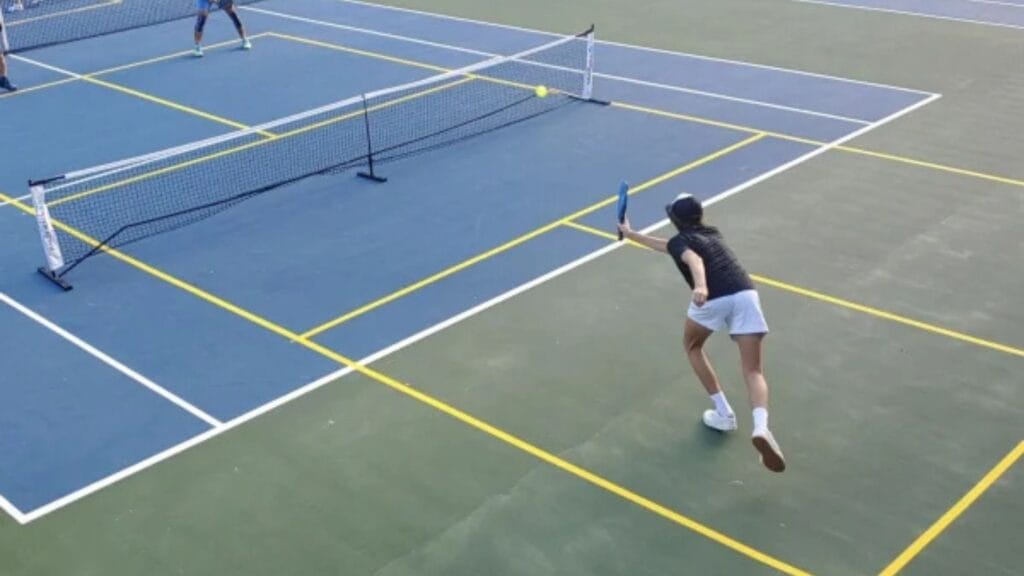Looking for the best mixed doubles pickleball strategy? Pickleball is already a wildly popular and enjoyable sport, but when it comes to mixed doubles, the game changes in more ways than one. It’s not just about hitting the ball over the net anymore.
Mixed doubles brings a whole new dynamic to the court, where both teamwork and understanding each other’s strengths make a massive difference. If you’ve ever found yourself in the middle of a match thinking, “We’re just not in sync,” then you’ve already discovered how important strategy is.
The good news is you’re not alone. And better yet, strategy is something you can learn, adapt, and use to win more matches.
When men and women partner up in pickleball, the game becomes a test of coordination, communication, and smart shot selection. Often, teams fall into the trap of treating it like two singles games on one court.
But that mindset usually leads to missed opportunities and avoidable errors. Instead, by embracing the unique aspects of mixed doubles and applying some clear, effective strategies, you’ll start to notice more wins, better rallies, and way fewer frustrating moments.
So if you’re ready to stop guessing and start winning, this guide will help.
Mixed Doubles Pickleball Strategy
Mixed doubles in pickleball isn’t just about playing your own best game. It’s about elevating your partner’s play as well. A good team doesn’t just return the ball well or hit hard; they know when to switch, when to hold their ground, and how to outthink their opponents.
That starts with a clear strategy. Whether you’re at the baseline or the net, both players need to understand their roles and be on the same page. And here's the truth: when strategy is missing, even talented players struggle.
In mixed doubles, strategy often revolves around one simple concept—teamwork. That includes where each partner should stand, how you move together, and when to attack versus when to defend.
It also means knowing which player should take which shot, how to avoid crossing paths, and how to keep your opponents guessing. Strategy, in this case, isn’t about one big trick or secret play.
It’s about consistently making smart decisions and avoiding the common mistakes that mixed doubles players often make. The more you practice these strategies, the more natural they’ll feel, and the better you’ll play as a team.
Suggested reading: Pickleball Strategies for Doubles: Never Lose Again In Doubles
Communication is Everything
If you ask any experienced mixed doubles team what helped them the most, they’ll likely mention communication. It’s truly the glue that holds the team together.
From calling shots to announcing who’s taking the middle ball, clear, loud, and respectful communication helps avoid confusion. It’s tempting to assume your partner will get that ball or cover that space, but assumptions lead to errors. And in pickleball, small mistakes can cost big points.
Good communication also means checking in after points, giving each other encouragement, and keeping the mood light. Pressure can build fast in tight games, so using positive words can help your partner stay focused and confident.
Something as simple as saying “nice shot” or “let’s shake it off” can turn the tide when the match isn’t going your way. Ultimately, couples or friends who talk openly during the game tend to move better, play smarter, and win more often.
The better you communicate, the more you can anticipate each other’s moves and avoid the dreaded collision in the middle of the court.
If you watch the pros, you will see that for most of them, communication is the answer to success. Find out which pros to follow by reading Best Pickleball Players: 20 Pros At The Top Of The Game In 2025.
Who Takes the Middle?
The middle of the court can be a tricky area in mixed doubles. Many teams struggle to decide who should take balls that land between them. Without a clear plan, players may hesitate, resulting in a missed shot or weak return.
In general, the stronger forehand should control the middle. Often, this is the male player, but not always. What matters is that both players know who owns that space and trusts each other to cover it.
A good rule of thumb is to have the partner with the forehand in the middle be responsible for those shots. It’s usually easier to step into the middle with a forehand than to reach across with a backhand.
But don’t forget—this should be discussed and agreed upon before the match starts. Being proactive helps avoid confusion.
The moment both players pull back from a shot, it gives the opponents a golden opportunity. So talk it over, practice it, and stick with the plan until it becomes second nature.
When it comes to an effective mixed doubles pickleball strategy, understanding which teammate will cover certain parts of the court is crucial to win.
Stay in Sync with Movement
One of the most beautiful things to watch in mixed doubles is a team that moves together like a well-oiled machine. They shift side to side, up and back, always maintaining the same distance and direction.
It looks effortless, but it takes practice. Staying in sync helps keep the court covered, reduces open space, and keeps pressure on the opponents. If one partner rushes forward while the other hangs back, gaps appear. That’s when sharp players exploit the opening and hit winners.
To avoid this, think of yourself as being connected by an invisible rope to your partner. If they move left, you move left. If they inch up to the kitchen line, you follow.
This kind of coordination creates a wall that’s hard to break through. It also helps with setting up shots. When both players are at the net, they can apply pressure together.
If one player is deep and the other is up, then angles open up for the other team. Movement may seem small, but it’s one of the key building blocks of a strong mixed doubles pickleball strategy.
To get better at movement, practice playing singles which can rapidly improve your mobile game. If you need advice on how to excel in singles to improve your mixed doubles strategy, then go read Pickleball Singles Strategy for Advanced Players.
Know When to Dink and When to Drive
Pickleball isn’t just about hard shots. The soft game matters too, especially in mixed doubles. Dinking is a valuable tool that slows the game down and forces your opponents to make errors.
If both teams are at the net, a well-placed dink can set up a pop-up or force someone out of position. However, some teams fall into the trap of dinking too long or without purpose. The key is knowing when to dink and when to speed it up.
Driving the ball with pace should come into play when you see an opportunity, like a ball that’s a little too high or when your opponents are off-balance. Dinking is like playing chess.
You want to move your opponent where you want them to go. Then, once the window opens, hit a fast shot that they can’t return.
Mixing these two elements keeps your opponents on their toes. They won’t know if you’re going to go soft or bring the heat. That unpredictability gives your team a real advantage.
Use Stacking to Your Advantage
Stacking may sound fancy, but it’s simply a smart way to position yourselves to play to your strengths. It’s a strategy where both players start on the same side of the court and then quickly switch after the serve or return.
In mixed doubles, this tactic is often used to keep the stronger forehand or more aggressive player in the middle. That way, they can control more of the court and take more shots.
The key to successful stacking is good planning and fast footwork. You don’t want to confuse your partner or cause a fault by being out of position. Practice makes perfect.
Try different formations in casual games and see which ones work best. Stacking can feel awkward at first, but with repetition, it becomes second nature. Once you get the hang of it, you’ll wonder how you ever played without it.
Target the Weaker Opponent
Every team has strengths and weaknesses. It’s not about disrespect—it’s about being strategic. Often, one player may have less experience or struggle with certain shots.
In mixed doubles, this might be the player who plays fewer competitive games or has slower reactions. The best strategy is to identify who that player is early in the match and direct more shots their way.
This doesn’t mean every shot needs to go to them. Instead, think of it like building pressure. Hit soft shots that pull them out wide. Return balls that test their backhand.
Lob over them if they struggle with overheads. Over time, this causes fatigue and opens up more chances for winning points. And if they adjust and play stronger? Even better. It pushes you to raise your game as well.
Stay Calm Under Pressure
Mixed doubles matches can get intense. Emotions run high, especially during close games or tournaments. But the team that stays calm usually comes out on top.
When you get frustrated or start blaming your partner, everything falls apart. Staying positive, even after mistakes, keeps your team focused and confident.
Use timeouts wisely. Take a deep breath. Walk back to the baseline and reset. If you feel the energy slipping, give your partner a smile or a high-five. Confidence can be contagious.
The moment you let go of negative energy, the clearer your decisions become. Remember, one point doesn’t decide a match. But one meltdown might.
Be Unpredictable with Your Shots
If your opponent knows where the ball is going every time, they will adjust and return with ease. That’s why mixing up your shots is so important. Don’t always go cross-court.
Don’t always use power. Throw in a drop shot, then follow it up with a deep lob. Mix drives with dinks. When you become unpredictable, your opponents can’t settle into a rhythm.
Think of your game like a recipe. A bit of spice, a dash of sweetness, and a few surprises keep things exciting. By using different shot speeds, directions, and placements, you create hesitation.
And hesitation leads to mistakes. You don’t need to be flashy—just unpredictable enough to keep your opponents guessing.
Practice Poaching the Right Way
Poaching in pickleball means stepping into your partner’s territory to take a shot, usually to attack or surprise the opponent. When done right, it’s a powerful tool.
But when done wrong, it can confuse your partner and leave the court wide open. That’s why timing and communication matter so much.
The best time to poach is when you notice your opponent repeating a pattern. Maybe they always return down the middle. Maybe their backhand is weak. If you see it coming, make your move.
But don’t just dart in unexpectedly. Use eye contact or a quick signal before the serve. Let your partner know it’s coming. This way, the switch feels seamless, not chaotic.
Master the Return of Serve
Returning the serve may seem like a small part of the game, but in mixed doubles, it’s crucial. A good return puts your team on the offensive.
Aim to return deep, ideally toward the backhand of the opponent who struggles more. This pushes them away from the net and gives your team time to move forward.
Avoid hitting the ball high or short unless you want to invite an attack. Instead, focus on placement. A deep return slows down your opponents and prevents them from rushing the kitchen line.
If you can control the return, you control the pace of the rally. That sets you up for more winning opportunities.
Cover the Gaps
A common issue in mixed doubles is leaving the center open. That space is like a welcome sign for your opponents if left unguarded. It’s also the area that leads to most unforced errors. Whether you’re playing with a seasoned partner or someone new, always talk about who covers the middle.
You can also practice a “gap-close” technique. When you notice a cross-court shot coming in, shift slightly toward your partner’s side to help cover the middle. Just a step or two makes a big difference. Over time, your awareness of the court will grow, and those gaps will disappear.
Use the Kitchen Line
The no-volley zone, or kitchen line, is where many points are won or lost. In mixed doubles, the team that controls the kitchen usually controls the game.
Once you and your partner get to the net, stay low and ready. Keep your paddle up and your eyes sharp. Dinks, drops, and quick volleys happen fast.
Avoid floating balls when you're near the kitchen. A high return gives your opponent an easy put-away. Instead, focus on placing shots that force them to bend, stretch, or move sideways. Pressure builds fast at the net, and one great shot can tip the rally in your favor.
Pro Pickleball Tips That Will Instantly Improve Your Game goes over kitchen line tips along with other really important ways to upgrade your level of play.
Don’t Overcoach on the Court
This one’s important, especially for couples. Giving tips or corrections mid-match might seem helpful, but it often causes tension. Instead of coaching your partner during points, save your advice for after the game or during a timeout. Let your partner play their game. Trust them.
Encouragement always works better than criticism. If they make a mistake, a quick “we got this” goes a lot further than “you should have hit that.” Keep your energy supportive and focused on the team. At the end of the day, pickleball is supposed to be fun.
Practice Together Off the Court
The best mixed doubles teams don’t just play matches—they train together. Spend time drilling specific skills like dinking, lobbing, or cross-court volleys.
Work on stacking, poaching, and movement drills. The more time you put in off the court, the more natural your strategy feels during a game.
Also, don’t forget about conditioning. Pickleball may look easy, but long rallies, quick cuts, and sudden changes of direction take a toll.
A little cardio, agility work, or even yoga can improve your endurance and flexibility. When you feel great physically, your mind stays sharp too.
You might also like: Pickleball Singles Tips: Expert Guide To Winning Singles Matches
FAQs about Mixed Doubles Pickleball Strategy
What is the biggest difference in mixed doubles strategy compared to regular doubles?
Mixed doubles focuses more on court positioning and using each player’s strengths. Teamwork plays a bigger role than individual skill.
Should I always let my partner take the middle shots?
It depends. If your partner has the stronger forehand, let them take middle shots. But always agree before the game.
How important is stacking in mixed doubles?
Stacking can help put the stronger player in the middle more often. It’s not required, but it’s a great strategic tool.
What if my partner and I keep clashing during points?
Communication is key. Talk before the game about roles and who covers what. Stay calm and focus on the team.
How do I know when to dink or drive?
Use dinks to move your opponents. Drive when they pop one up or seem off balance. Mix it up often.
Can switching sides in mixed doubles confuse the other team?
Yes! Sudden switches or unexpected poaching can throw off your opponents. Just make sure your partner is ready.
Final Thoughts on Mixed Doubles Pickleball Strategy
Winning in mixed doubles isn’t about power or fancy trick shots. It’s about connection, smart decision-making, and consistent teamwork.
When both players understand their roles, talk openly, and move in harmony, magic happens. You’ll start to feel unstoppable—not because you’re hitting harder, but because you’re playing smarter.
Remember, every match is a chance to grow. You won’t win them all, and that’s okay. What matters is how you learn from each game and come back stronger.
Pickleball is as much about relationships as it is about rallies. So laugh often, stay positive, and keep playing. The more you enjoy the process, the more success you’ll find.




